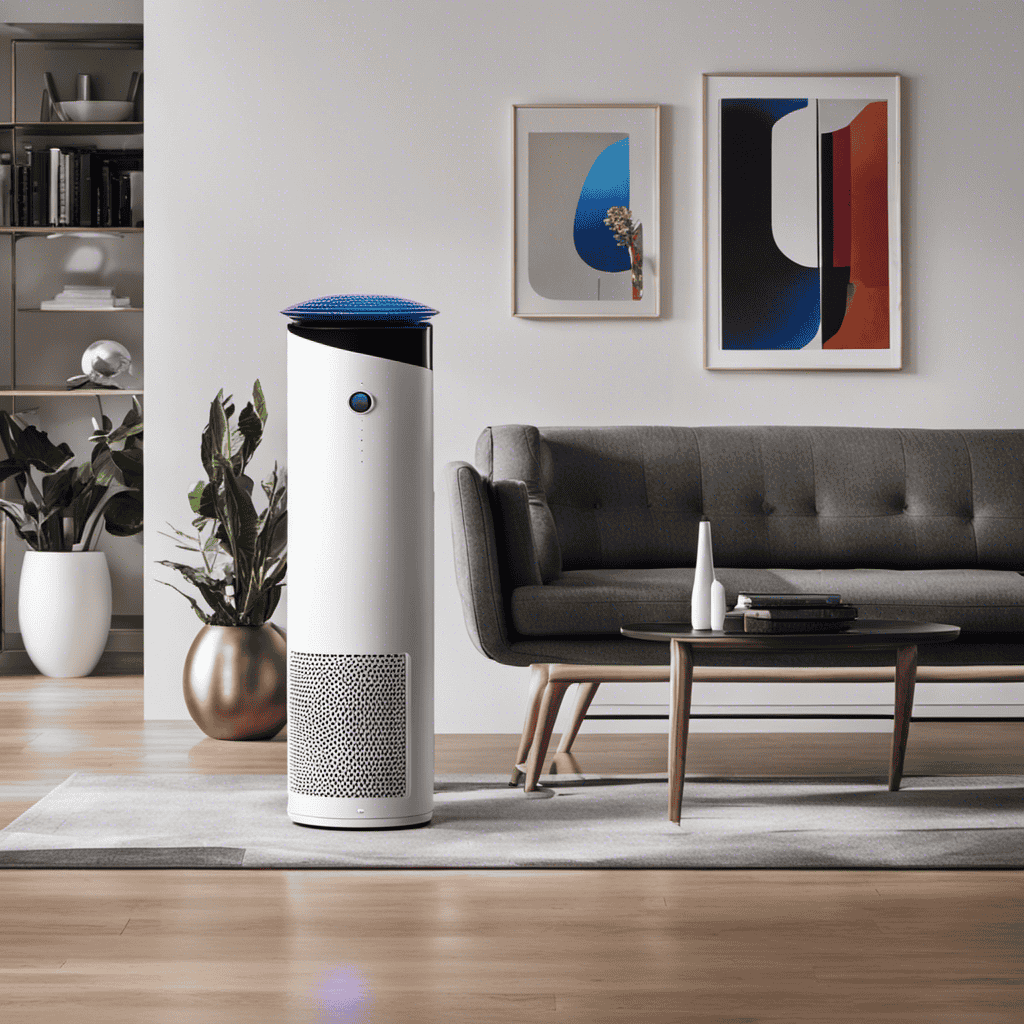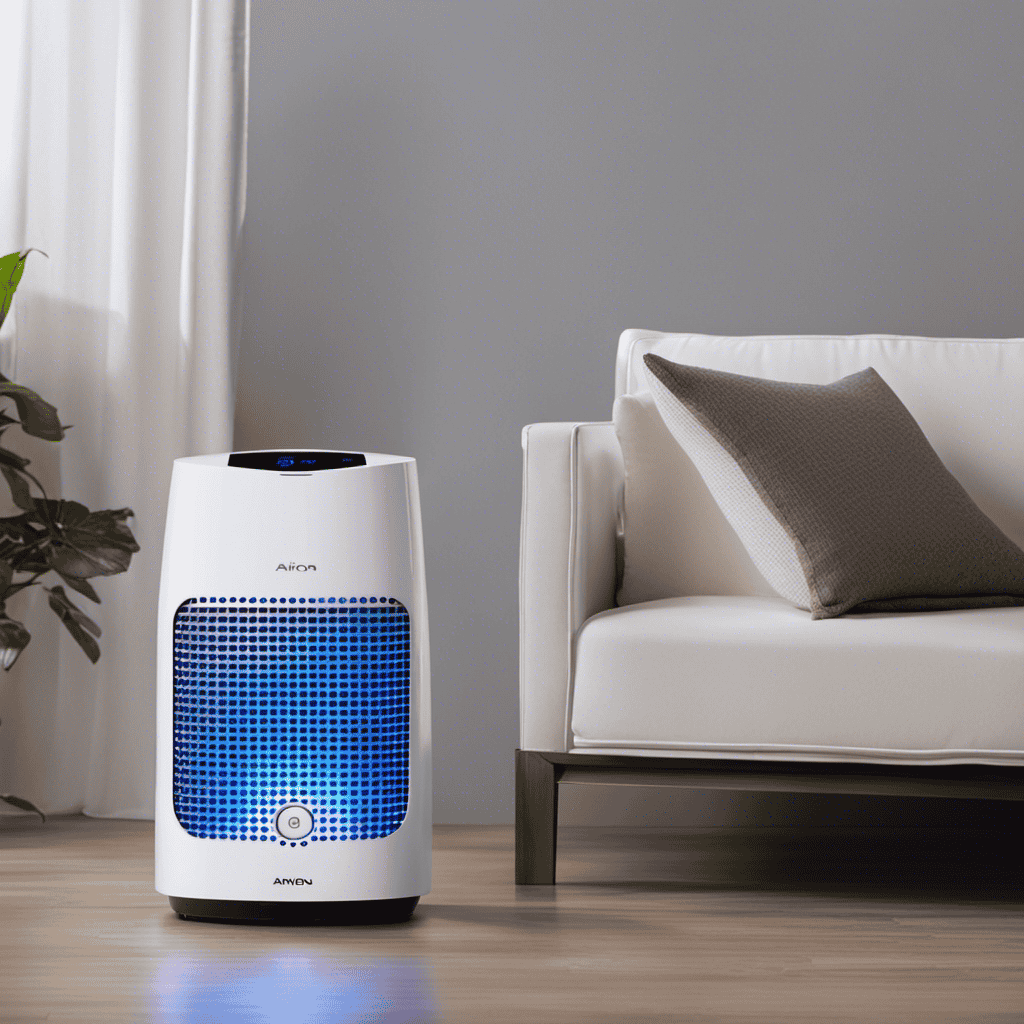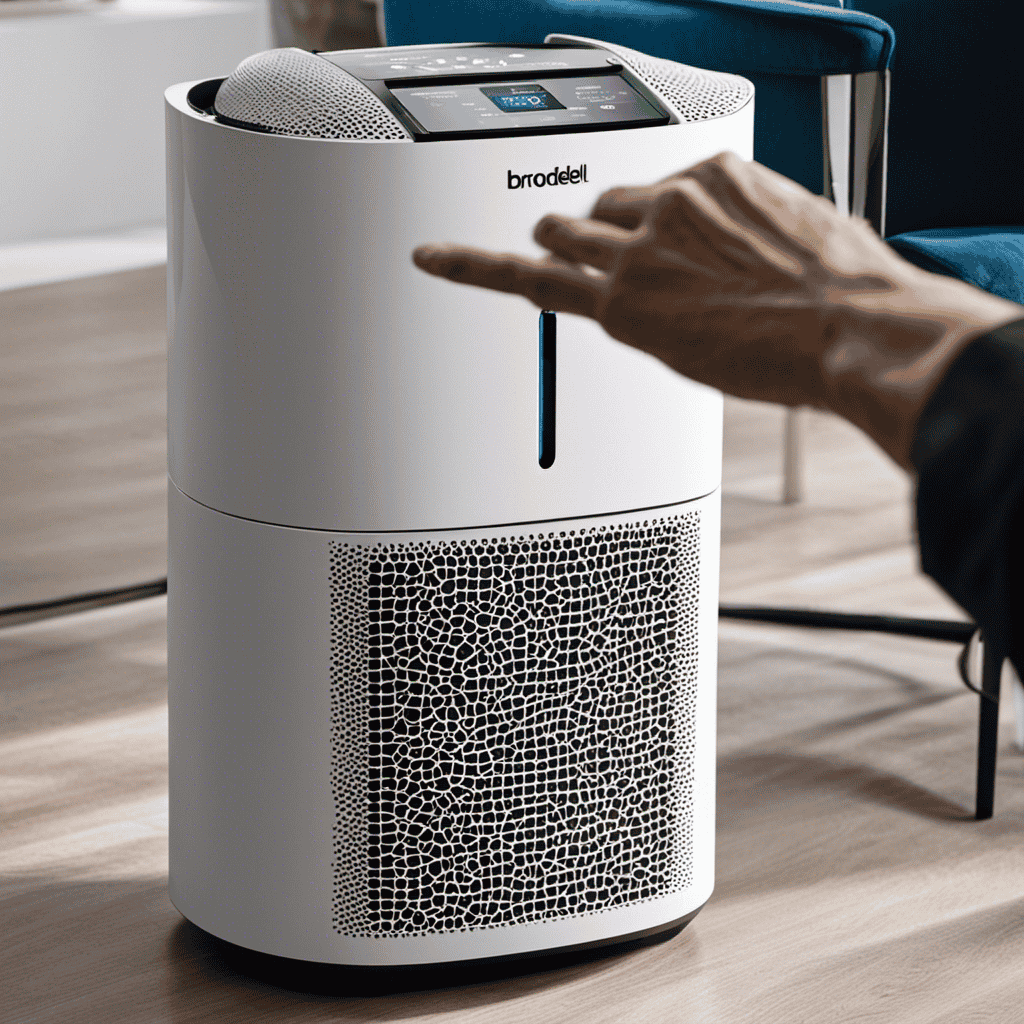As a person with allergies, I recognize the significance of having clean air in my household.
Did you know that indoor air can be up to five times more polluted than outdoor air? That’s where UV air purifiers come in. These innovative devices use ultraviolet light to eliminate airborne allergens, viruses, and bacteria, providing a sustainable solution for cleaner indoor air.
In this article, we will delve into the science behind UV air purifiers, explore their benefits, and discuss how they can improve symptoms for those with asthma.
Key Takeaways
- UV air purifiers are effective in killing airborne pathogens and reducing the spread of infectious diseases.
- UV purification provides a more hygienic environment by eliminating harmful microorganisms and reducing allergies and asthma symptoms.
- UV air purifiers require minimal maintenance and help remove unpleasant odors by breaking down volatile organic compounds (VOCs).
- UV air purifiers play a crucial role in hospitals by combating airborne pathogens, improving respiratory health, enhancing indoor air quality, and supporting infection control measures.
The Science Behind UV Air Purifiers
UV air purifiers use ultraviolet light to kill airborne pathogens, such as bacteria and viruses, helping to improve the overall air quality in your home.
The use of UV-C light in air purification has been extensively studied and proven to be effective in reducing the spread of infectious diseases. UV-C light works by damaging the DNA and RNA of microorganisms, rendering them unable to replicate and causing their death.
This technology has been widely adopted in hospitals, laboratories, and other high-risk environments to control the spread of pathogens. UV air purifiers are equipped with specially designed lamps that emit UV-C light, effectively neutralizing harmful microorganisms in the air.
Understanding UV-C Light and Air Purification
When it comes to understanding the effectiveness of UV-C light in air purification, several key points need to be considered.
First, it is important to explain how UV-C light works to kill or inactivate harmful microorganisms such as bacteria and viruses.
Second, exploring the benefits of UV purification can shed light on why it has become a popular method for improving indoor air quality.
Lastly, discussing safety precautions for UV is crucial to ensure that users are aware of the potential risks associated with its use and can take appropriate measures to protect themselves.
UV-C Effectiveness Explained
The effectiveness of UV-C in air purifiers can be explained by how it neutralizes harmful microorganisms. UV-C light benefits air purifiers by breaking down the DNA and RNA of bacteria, viruses, and other pathogens, rendering them inactive and unable to reproduce. This powerful disinfection process eliminates airborne contaminants and helps improve indoor air quality.
Numerous studies have demonstrated the effectiveness of UV-C in reducing microbial contamination in air purification systems. For example, a study published in the Journal of Virological Methods found that UV-C irradiation significantly reduced the concentration of airborne influenza A viruses. Another study conducted by the National Research Council of Canada showed that UV-C light effectively inactivated the SARS coronavirus.
These findings highlight the importance and effectiveness of UV air purifiers in combating harmful microorganisms and promoting a healthier living environment.
Benefits of UV Purification
You can benefit from a UV purification system by enjoying cleaner and healthier indoor air quality. Here are the advantages of using UV air purifiers:
-
Eliminates harmful microorganisms: UV light has the ability to destroy bacteria, viruses, and mold spores, providing a more hygienic environment.
-
Reduces allergies and asthma: By neutralizing allergens such as pollen and pet dander, UV purification can help alleviate symptoms for those with respiratory conditions.
-
Odor removal: UV light breaks down volatile organic compounds (VOCs) which are responsible for unpleasant smells, leaving your space fresh and odor-free.
-
Low maintenance: UV purifiers require minimal maintenance, with only periodic bulb replacement needed.
These benefits make UV purification a valuable addition to any indoor space.
However, it is important to take safety precautions when using UV systems to ensure optimal effectiveness and avoid any potential risks.
Safety Precautions for UV
It’s crucial to follow safety precautions to ensure optimal effectiveness and avoid potential risks when using a UV system.
UV air purifiers are a popular choice for improving indoor air quality, but it’s important to remember that they emit ultraviolet radiation, which can be harmful if not used properly.
To protect yourself and others, it’s essential to take safety measures. First and foremost, always read and follow the manufacturer’s instructions for installation and operation.
Additionally, limit your exposure to the UV light by avoiding direct contact with the purifier and ensuring that it is installed in a location where it can effectively clean the air without causing unnecessary exposure.
It’s also advisable to consider UV exposure limits recommended by experts to minimize any potential health risks associated with prolonged exposure to UV radiation.
Benefits of Using a UV Air Purifier in Your Home
Using a UV air purifier in your home can significantly improve indoor air quality. Here are four key benefits of using a UV air purifier:
-
Eliminates airborne pathogens: UV air purifiers use ultraviolet light to kill bacteria, viruses, and other harmful microorganisms in the air, reducing the risk of infections and illnesses.
-
Reduces odors: UV air purifiers can effectively neutralize unpleasant odors caused by pets, cooking, or mold and mildew, leaving your home smelling fresh and clean.
-
Removes allergens: UV air purifiers can capture and destroy common airborne allergens like pollen, dust mites, and pet dander, providing relief for allergy sufferers.
-
Improves respiratory health: By removing pollutants and allergens from the air, UV air purifiers can help alleviate respiratory symptoms and improve overall lung health.
How UV Air Purifiers Help Reduce Airborne Allergens
I’ve found that UV air purifiers are effective in reducing airborne allergens in my home. UV rays have the ability to kill allergens such as mold spores, bacteria, and viruses, improving indoor air quality.
This has led to a noticeable reduction in allergy symptoms for myself and my family.
UV Kills Allergens
UV air purifiers are effective against viruses and allergens for several key reasons.
-
Microbial Elimination: UV light has been proven to effectively eliminate microorganisms, including viruses, bacteria, and mold spores. It damages their DNA, rendering them unable to multiply and causing their death.
-
Reduced Allergens: UV air purifiers not only kill allergens like dust mites, pet dander, and pollen, but they also prevent them from reproducing. This significantly reduces the presence of these allergens in the air, providing relief to allergy sufferers.
-
Improved Indoor Air Quality: UV air purifiers work in conjunction with filtration systems to capture and neutralize airborne particles. By eliminating allergens and viruses, they contribute to improved indoor air quality and reduce the risk of respiratory illnesses.
-
Long-lasting Effectiveness: Unlike chemical-based disinfectants, UV air purifiers provide continuous, long-lasting protection. They operate 24/7, ensuring that the air remains free from allergens and viruses at all times.
With UV air purifiers effectively killing allergens, it’s clear that they play a vital role in improving indoor air quality and promoting a healthier living environment.
Improved Indoor Air Quality
You’ll notice a significant improvement in the quality of the air indoors when using a UV air purifier. These devices are highly effective at eliminating airborne pollutants, which can have a significant impact on respiratory health.
Airborne pollutants such as dust, pollen, mold spores, and pet dander can trigger allergies and worsen respiratory conditions like asthma. UV air purifiers use ultraviolet light to kill and deactivate these allergens, ensuring cleaner and healthier air.
Numerous studies have shown the effectiveness of UV air purifiers in reducing airborne contaminants, providing relief for individuals suffering from respiratory issues.
Reduces Allergy Symptoms
Using a UV air purifier can greatly reduce allergy symptoms by eliminating airborne allergens. Here are four ways in which UV air purifiers can help in reducing respiratory issues and preventing asthma attacks:
-
Elimination of airborne allergens: UV air purifiers use ultraviolet light to kill bacteria, viruses, and mold spores, which are common triggers for allergies and respiratory problems.
-
Sterilization of the air: UV light has the ability to sterilize the air by destroying the DNA of microorganisms, making the air cleaner and safer to breathe.
-
Reduction of indoor pollutants: UV air purifiers can also help to reduce indoor pollutants such as pet dander, pollen, and dust mites, all of which can cause allergic reactions and exacerbate respiratory issues.
-
Improved air circulation: UV air purifiers work in conjunction with the ventilation system to continuously circulate and filter the air, ensuring that allergens and irritants are effectively removed.
UV air purifiers provide a powerful solution for reducing allergy symptoms and improving indoor air quality. However, it is important to understand the difference between UV air purifiers and traditional air purifiers to make an informed decision about which is best for your needs.
UV Air Purifiers Vs. Traditional Air Purifiers: What’s the Difference
When it comes to UV air purifiers versus traditional air purifiers, what sets them apart?
UV air purifiers are a type of air purification system that uses ultraviolet light to kill or deactivate airborne pathogens such as bacteria, viruses, and mold spores. These purifiers work by emitting UV-C light, which damages the DNA of these microorganisms, preventing them from reproducing and spreading. This technology offers several benefits, including improved indoor air quality and reduced risk of illness.
On the other hand, traditional air purifiers use filters to trap pollutants such as dust, pollen, and pet dander. While they are effective at removing larger particles, they may not be as efficient in eliminating microorganisms.
UV air purifiers, with their ability to kill pathogens, offer a more comprehensive approach to air purification.
The Role of UV Air Purifiers in Eliminating Viruses and Bacteria
In my previous discussion about the differences between UV air purifiers and traditional air purifiers, I highlighted the unique features of UV air purifiers in eliminating viruses and bacteria. Now, let’s delve deeper into the role of UV air purifiers in hospitals and their impact on respiratory health.
-
Benefits of UV air purifiers in hospitals: UV air purifiers have been widely embraced in hospitals due to their ability to combat airborne pathogens effectively. By utilizing ultraviolet germicidal irradiation (UVGI), these purifiers can neutralize viruses, bacteria, and fungi, reducing the risk of hospital-acquired infections. This is especially crucial in high-risk areas such as operating rooms and intensive care units.
-
Reducing respiratory health risks: The presence of allergens, pollutants, and pathogens in the air can have detrimental effects on respiratory health. UV air purifiers can help mitigate these risks by eliminating harmful particles, reducing the likelihood of respiratory infections, allergies, and asthma attacks.
-
Enhancing indoor air quality: Hospitals require a clean and sterile environment to ensure the well-being of patients and staff. UV air purifiers play a vital role in improving indoor air quality by removing contaminants, unpleasant odors, and volatile organic compounds (VOCs), creating a safer and healthier environment for all.
-
Supporting infection control measures: UV air purifiers act as an additional layer of defense against infectious diseases in hospitals. By continuously purifying the air, these devices contribute to the overall infection control measures, providing an added level of protection for patients, healthcare workers, and visitors.
Overall, the benefits of UV air purifiers in hospitals are evident. They not only help eliminate viruses and bacteria but also have a positive impact on respiratory health, enhance indoor air quality, and support infection control measures. Incorporating UV air purifiers into hospital settings can be a valuable strategy in improving patient outcomes and ensuring a safer healthcare environment.
UV Air Purifiers and Asthma: Can They Help Improve Symptoms
UV air purifiers can provide relief for individuals with asthma by reducing the presence of allergens and pollutants in the air. Asthma is a chronic respiratory condition that can be triggered by various factors, including indoor air pollution. Dust mites, pet dander, mold spores, and volatile organic compounds (VOCs) are common indoor allergens that can worsen asthma symptoms. UV air purifiers use ultraviolet (UV) light to kill or deactivate these allergens and pollutants, helping to improve respiratory health for asthma sufferers. Research has shown that UV air purifiers can effectively reduce the levels of allergens and pollutants in indoor environments, leading to a decrease in asthma symptoms such as coughing, wheezing, and shortness of breath. By targeting these harmful particles, UV air purifiers offer a viable solution for individuals with asthma to breathe cleaner and healthier air.
Now that we understand how UV air purifiers can help improve respiratory health for asthma sufferers, let’s explore how they can also be a sustainable solution for cleaner indoor air.
UV Air Purifiers: A Sustainable Solution for Cleaner Indoor Air
Using UV air purifiers is a sustainable way to achieve cleaner indoor air. These devices use ultraviolet light to neutralize harmful pathogens, such as bacteria, viruses, and mold spores, in the air. Here are four reasons why UV air purifiers have sustainability benefits and a long-term impact:
-
Energy efficiency: UV air purifiers consume less energy compared to traditional air purifiers, making them a more sustainable choice. They use UV-C lamps to kill microorganisms, which require less power than running a fan or a motor.
-
Reduced chemical usage: UV air purifiers eliminate the need for chemical disinfectants, which can have negative environmental impacts. By relying on UV light, these purifiers provide a chemical-free solution to clean indoor air.
-
Extended filter life: UV air purifiers can prolong the lifespan of traditional filters. By neutralizing pathogens before they reach the filter, UV purifiers help reduce the frequency of filter replacements, resulting in less waste.
-
Improved air quality: By effectively eliminating harmful microorganisms, UV air purifiers contribute to healthier indoor environments. This can lead to improved respiratory health, reduced allergy symptoms, and a higher overall quality of life.
Frequently Asked Questions
How Much Does a UV Air Purifier Cost?
UV air purifiers can vary in cost depending on the brand and features. When considering a UV air purifier, it’s important to do a cost comparison and research the best brands to ensure you are getting the most value for your money.
Are UV Air Purifiers Effective at Removing Pet Dander and Pet Odors?
Eliminating pet dander and odors, UV air purifiers effectively improve indoor air quality. Their impact on reducing these allergens is significant, making them a valuable tool for maintaining a clean and healthy home environment.
Can UV Air Purifiers Help With Mold and Mildew Issues in the Home?
UV air purifiers can help with mold and mildew issues in the home by eliminating harmful bacteria and preventing respiratory infections. They are an important addition to any household concerned about indoor air quality.
Do UV Air Purifiers Produce Any Harmful Byproducts or Emissions?
UV air purifiers can produce harmful byproducts and emissions. It is important to consider the potential health risks associated with these devices. Research on specific models and their emission levels is crucial before making a decision.
How Often Do UV Bulbs Need to Be Replaced in a UV Air Purifier?
UV bulbs in air purifiers typically need replacement every 9-12 months to maintain optimal performance. Regular maintenance ensures efficient air purification, maximizing the lifespan of the purifier and reducing potential health risks caused by airborne contaminants.
Conclusion
After exploring the science behind UV air purifiers and their benefits, it is clear that they play a crucial role in improving indoor air quality.
UV air purifiers are effective in reducing airborne allergens, eliminating viruses and bacteria, and even helping with asthma symptoms.
They offer a sustainable solution for cleaner air in our homes.
Just like a bright light at the end of a tunnel, UV air purifiers shine a path towards a healthier and safer environment for us all.










